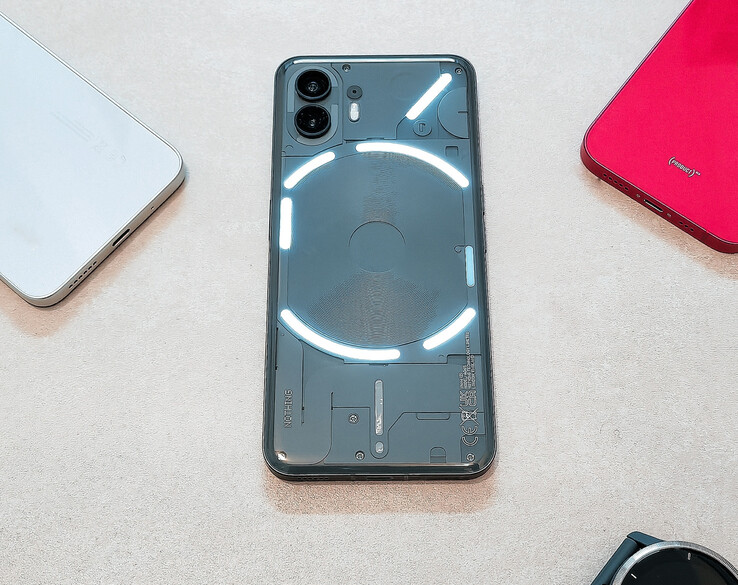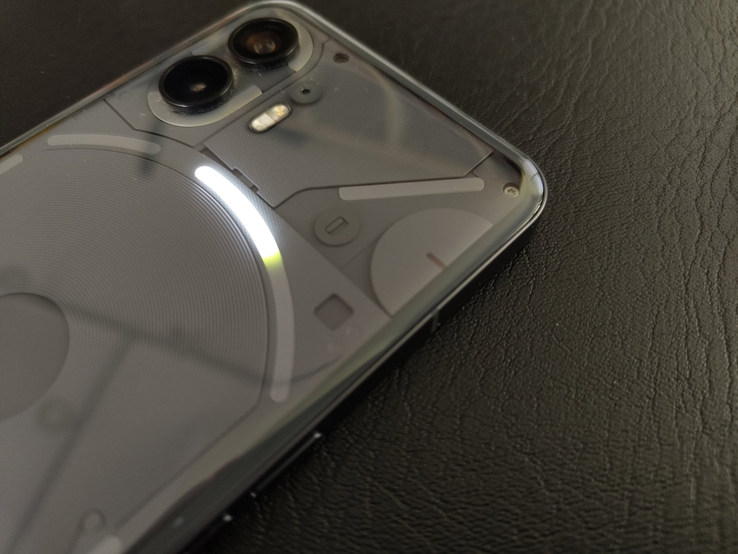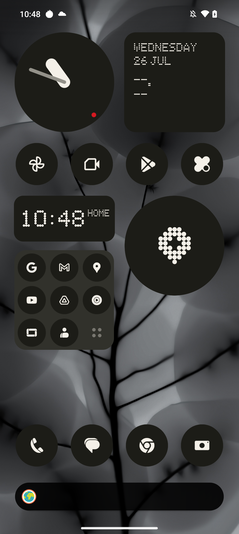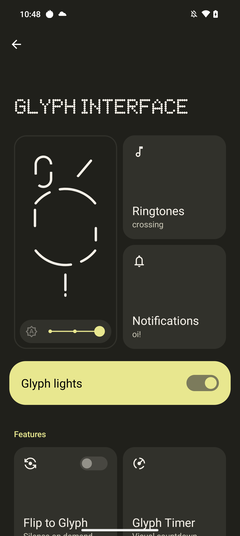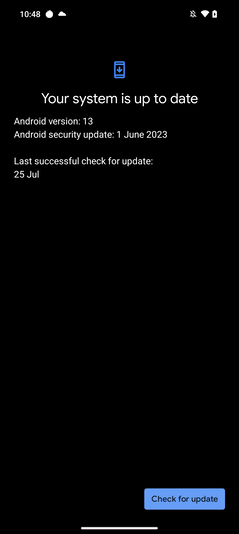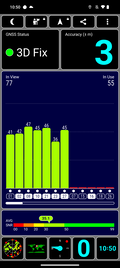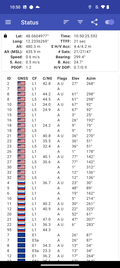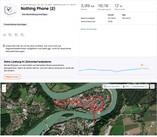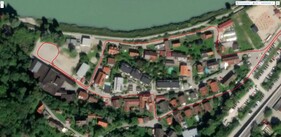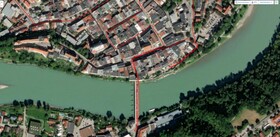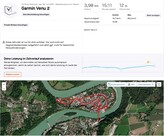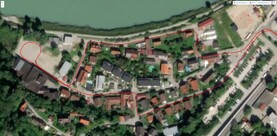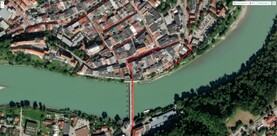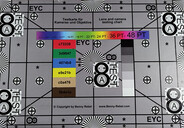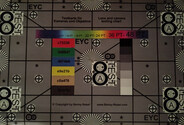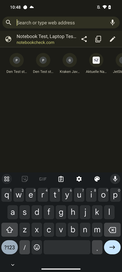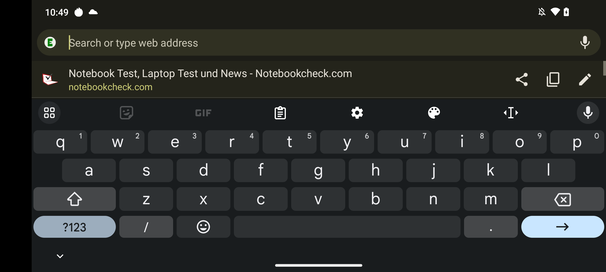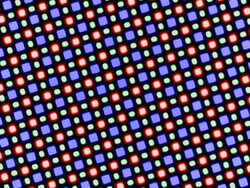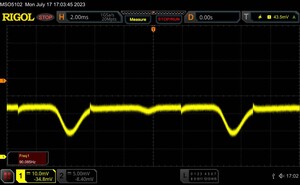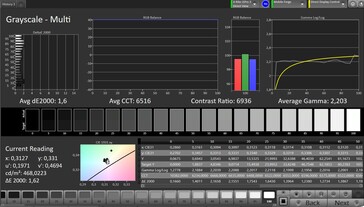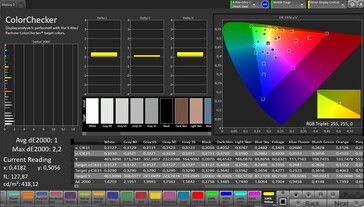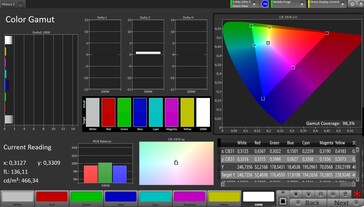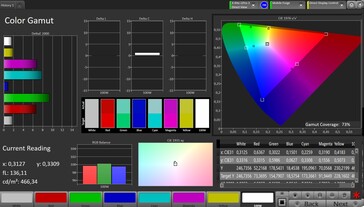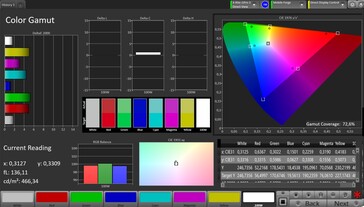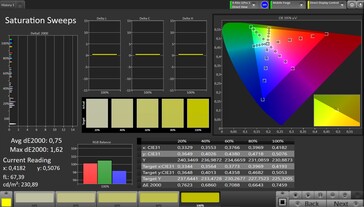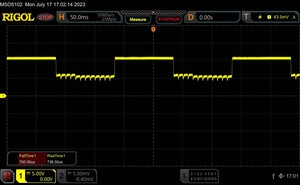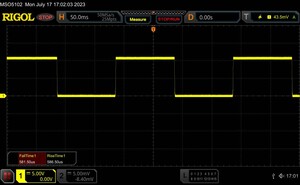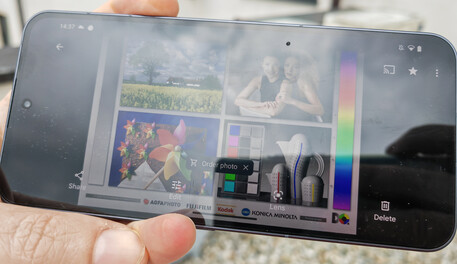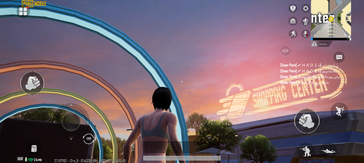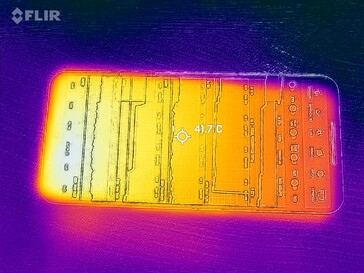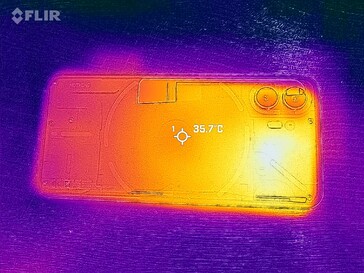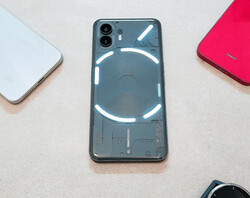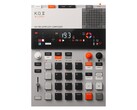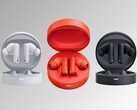Nothing Phone (2) review: LED effects in a fairly priced high-end smartphone
Nothing achieved respectable success with the Phone (1) and now the manufacturer intends to expand its lineup with the new Phone (2). Thanks to a real high-end SoC and even faster charging, the new model is expected to give competing flagship devices a run for their money. Although the Phone (2) is significantly more expensive than its predecessor, the decision to create a higher-quality device this year makes sense, as the Phone (1) can remain in the lineup and buyers have more choice.
Of course, the iconic Glyph interface made of numerous LEDs on the rear side is back and it has even been refined in some areas. Whether you should invest up to US$750 for the Nothing Phone (2) is something we examine in detail in our review.
Possible competitors in comparison
Rating | Date | Model | Weight | Drive | Size | Resolution | Price |
|---|---|---|---|---|---|---|---|
| 87.4 % v7 (old) | 07 / 2023 | Nothing Phone (2) SD 8+ Gen 1, Adreno 730 | 201.2 g | 256 GB UFS 3.1 Flash | 6.70" | 2412x1080 | |
| 85.6 % v7 (old) | 07 / 2022 | Nothing Phone (1) SD 778G+ 5G, Adreno 642L | 193.5 g | 256 GB UFS 3.1 Flash | 6.55" | 2400x1080 | |
| 86.4 % v7 (old) | 01 / 2023 | Xiaomi 12T Dimensity 8100, Mali-G610 MP6 | 202 g | 256 GB UFS 3.1 Flash | 6.67" | 2712x1220 | |
| 86.4 % v7 (old) | 07 / 2023 | Huawei Nova 11 Pro SD 778G 4G, Adreno 642L | 188 g | 256 GB UFS 3.1 Flash | 6.78" | 2652x1200 | |
| 87 % v7 (old) | 08 / 2022 | OnePlus 10T SD 8+ Gen 1, Adreno 730 | 203.5 g | 256 GB UFS 3.1 Flash | 6.70" | 2412x1080 |
Case - Glyph interface with more options
The Nothing Phone (2) is somewhat heavier and slightly longer than its predecessor, but it also offers a larger screen and significantly more performance. Once again, the Nothing phone is protected by Gorilla Glass 5 on both sides, with the transparent back revealing the cable channels and wireless charging spiral. The rear glass is now curved so that the Nothing Phone (2) fits comfortably in the hand.
The sides are made of an aluminum frame that is reminiscent of current iPhones with its angular design and pill-shaped buttons. The Phone (2) comes in either Dark Grey or White.
The workmanship is pleasing: clean material transitions and small gaps create a high-quality look. However, we noticed in the course of our review that the smartphone can warp after prolonged exposure to the sun and the gaps then become larger. The warping subsides once it cools down, but previous reports about water and dust under the back of the predecessor make us wonder.
The housing is protected according to IP54, so the protection against splash water has been slightly improved compared to the predecessor. You shouldn't go swimming with Nothing Phone (2) though.
We like the fact that Nothing prints the device's CO2 footprint on the package and attempts to keep the environmental impact of the smartphone as low as possible via various measures, such as recycling materials in the device and plastic-free packaging. A detailed sustainability report on the Phone (2) can be found on the website.
The glyph interface is the design highlight of the smartphone. Underneath the transparent glass back there is a pattern of white LEDs that can simulate a count-down timer and display notifications, of which the number and function has been significantly expanded in the Phone (2). You can now use the Glyph Composer to create your own ringtones, and some third-party providers such as Uber are now using the function, for example, to display the time until the driver reaches their desired location.
Equipment - No eSIM support on the Nothing Phone (2)
The Nothing Phone (2) is available in three memory variants:
- 128 GB storage / 8 GB RAM: US$599
- 256 GB storage / 12 GB RAM: US$749
- 512 GB storage / 12 GB RAM: US$859
A microSD reader is missing, but there are 2 slots for nano-SIMs. Unfortunately, eSIMs are not supported. The USB-C port is still only connected internally via USB 2.0, so data transfers are slower and image output via USB cable is not possible.
Software - Also available wihout Nothing design upon request
Nothing OS 2.0 is based on Android 13 and is very stylish with its pixelated black and white design, but you have to get used to the icons without labels. Those who prefer the classic Android look can select this option during the setup or easily restore it afterwards, since Nothing implements its design mainly via icon packs and widgets that you can remove or change at any time.
No third-party advertising apps are preinstalled. The security patches on our device were from June 2023 and thus still reasonably up to date at the time of review. Nothing also released a number of minor updates with detailed patch notes during our review to improve the smartphone's features. Overall, the smartphone is expected to get security updates every 2 months for 4 years. In addition, 3 new Android versions are intended for the smartphone.
Communication and GNSS - Fast WiFi 6E on the Nothing phone
The Nothing Phone (2) comes with WiFi 6E, so it can take advantage of the less-used 6 GHz band. Under testing with our Asus ROG Rapture AXE11000 reference router, the WLAN connection proved to be quite stable after initial difficulties, but it is very unevenly fast when sending and receiving data, just like the Phone (1). Overall, the speeds are clearly above those of the predecessor.
Thanks to the many supported 4G and 5G frequencies, the Nothing Phone (2) can be used worldwide. The signal quality was consistently good during our 2-week review period and on par with other high-end smartphones.
| Networking | |
| iperf3 receive AXE11000 | |
| OnePlus 10T | |
| Xiaomi 12T | |
| Average of class Smartphone (52 - 1857, n=182, last 2 years) | |
| Huawei Nova 11 Pro | |
| iperf3 transmit AXE11000 | |
| Xiaomi 12T | |
| OnePlus 10T | |
| Huawei Nova 11 Pro | |
| Average of class Smartphone (49.8 - 1806, n=182, last 2 years) | |
| iperf3 transmit AXE11000 6GHz | |
| Nothing Phone (2) | |
| Average of class Smartphone (508 - 1945, n=85, last 2 years) | |
| Nothing Phone (1) | |
| iperf3 receive AXE11000 6GHz | |
| Average of class Smartphone (451 - 1864, n=85, last 2 years) | |
| Nothing Phone (2) | |
| Nothing Phone (1) | |
As soon as you step outside with the Nothing Phone (2), you are immediately pinpointed at an accuracy of 3 meters. All major satellite networks are supported, but not the SBAS system for even greater accuracy. Satellite positioning also takes place indoors, but this is not quite as accurate.
The smartphone's localization capabilities also have to undergo real-world testing, so we jumped on our bikes and took the Garmin Venu 2 smartwatch for comparison. The Nothing Phone (2) is very accurate; we observed only minimal deviations from the route taken in two places. We can thus highly recommended the smartphone as a navigation device.
Telephony and Voice Quality - It sounds better via loudspeaker
Nothing uses Android's standard phone app, so users who switch from other brands should find their way around right away.
The call quality is decent overall, but has a few weaknesses: the internal earpiece sounds a little muffled and neither the normal nor the hands-free microphone pick up quiet voices. If you listen to the other party via loudspeaker, the conversation sounds much clearer.
Cameras - New sensor for improved image quality
On paper, little seems to have changed in the cameras compared to the Nothing Phone (1). There are still two 50 megapixel lenses, but the manufacturer now installs a more modern Sony IMX 890 sensor in the main camera. The more powerful SoC also ensures that the camera functions more swiftly and can process photos faster.
Photos appear well-lit and full of realistic colors at first glance. However, the camera tends to omit details for more distant objects. The sensor takes sharp pictures in very low ambient light, but loses sharpness in very dark areas. The wide-angle lens, also 50 megapixels, takes decent pictures that can also be enlarged a little without much loss of detail.
What is missing are real zoom capabilities as known from higher quality camera systems. There is no periscope camera on the Nothing Phone (2); the best on offer here is a hybrid zoom, which is possible for both the wide-angle and main camera.
Overall, the Nothing Phone (2) can take good photos, but what about videos? The smartphone is able to record in 4K at 60 fps. Both the autofocus and brightness adjustment respond very quickly and reliably. The resulting films are pleasing, especially in bright lighting conditions.
A 32-megapixel camera sits on the front. It takes detailed selfies, which you can also enlarge a little, but there could be more sharpness in dark areas.
Image comparison
Choose a scene and navigate within the first image. One click changes the position on touchscreens. One click on the zoomed-in image opens the original in a new window. The first image shows the scaled photograph of the test device.
Main camera - flowerMain camera - surrounding environmentMain camera - low lightWide angleUnder full studio lighting in the lab, the main camera takes pleasing photos whose sharpness drops only slightly towards the edges. We very much like the contrast and level of detail. At just 1 lux illumination, the image is still clearly recognizable, but dark areas hardly offer any definition.
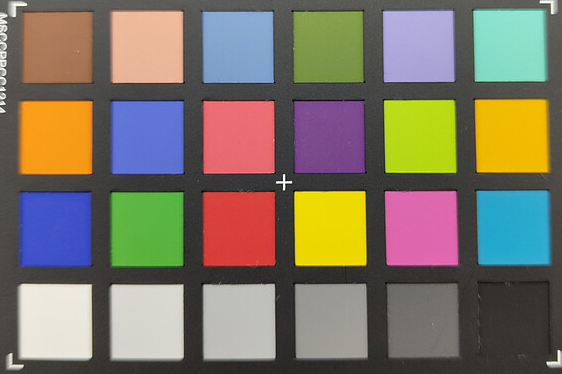
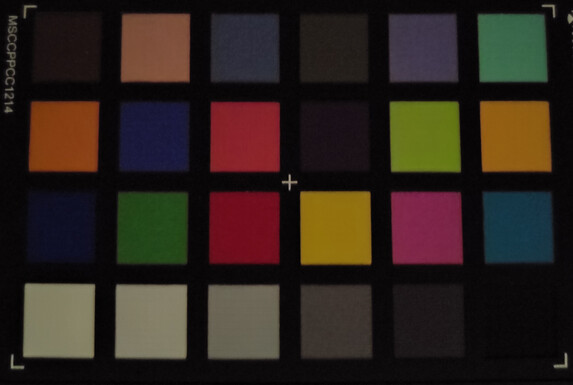
Accessories and Warranty – Charger not included
A charger is not included with the Nothing Phone (2). Instead, only a USB cable and a SIM tool are found in the box. The charger can be purchased in Nothing's webstore, the price of which varies from region to region (EUR 35 in Germany, for example). A protective case is also available for purchase.
The manufacturer offers a 24-month warranty for devices purchased in the EU. Of course, this may differ in other regions, so buyers should double check before purchasing.
Input Devices & Operation - Fingerprint sensor behind the screen
Thanks to its 120 Hz display, the smartphone can be operated very smoothly. The touchscreen is sensitive right up to the corners and also responds to very light touches. The screen's query rate can be further increased via an experimental feature, so that the smartphone can cope with demanding touch frequent scenarios such as gaming.
The fingerprint sensor is hidden behind the display, but is placed quite far down in portrait format so that you have to reach around to access it. It unlocks the smartphone almost immediately and recognizes stored fingerprints very reliably. Biometric unlocking via facial recognition is also possible, but only 2D images are used here, making this function susceptible to manipulation.
Display - Bright and with DC dimming
The OLED screen in the Nothing Phone (2) is 6.7 inches, has a resolution of 2,412 x 1,080 pixels and can display up to 120 frames per second.
We really like the screen's maximum brightness, which Nothing specifies as 1,000 cd/m². We almost reached this value in our tests during full-screen playback, and even higher brightness levels are possible for HDR content in smaller screen sections.
The screen uses DC dimming to adjust the flickering to the refresh rate, so it should be less bothersome. Nevertheless, sensitive people should test the screen at low brightness before buying.
| |||||||||||||||||||||||||
Brightness Distribution: 98 %
Center on Battery: 951 cd/m²
Contrast: ∞:1 (Black: 0 cd/m²)
ΔE ColorChecker Calman: 1 | ∀{0.5-29.43 Ø4.83}
ΔE Greyscale Calman: 1.6 | ∀{0.09-98 Ø5.1}
98.3% sRGB (Calman 2D)
Gamma: 2.203
CCT: 6516 K
| Nothing Phone (2) OLED, 2412x1080, 6.7" | Nothing Phone (1) OLED, 2400x1080, 6.6" | Xiaomi 12T AMOLED, 2712x1220, 6.7" | Huawei Nova 11 Pro OLED, 2652x1200, 6.8" | OnePlus 10T Fluid AMOLED, 2412x1080, 6.7" | |
|---|---|---|---|---|---|
| Screen | -17% | -11% | -47% | -53% | |
| Brightness middle | 951 | 620 -35% | 915 -4% | 729 -23% | 861 -9% |
| Brightness | 948 | 625 -34% | 914 -4% | 719 -24% | 856 -10% |
| Brightness Distribution | 98 | 98 0% | 98 0% | 92 -6% | 97 -1% |
| Black Level * | |||||
| Colorchecker dE 2000 * | 1 | 1.24 -24% | 1.1 -10% | 1.39 -39% | 2.27 -127% |
| Colorchecker dE 2000 max. * | 2.2 | 2.31 -5% | 2.7 -23% | 4.74 -115% | 4.17 -90% |
| Greyscale dE 2000 * | 1.6 | 1.7 -6% | 2 -25% | 2.8 -75% | 2.9 -81% |
| Gamma | 2.203 100% | 2.318 95% | 2.24 98% | 2.271 97% | 2.303 96% |
| CCT | 6516 100% | 6325 103% | 6457 101% | 6738 96% | 6141 106% |
* ... smaller is better
Screen Flickering / PWM (Pulse-Width Modulation)
| Screen flickering / PWM detected | 90 Hz | ||
The display backlight flickers at 90 Hz (worst case, e.g., utilizing PWM) . The frequency of 90 Hz is very low, so the flickering may cause eyestrain and headaches after extended use. In comparison: 53 % of all tested devices do not use PWM to dim the display. If PWM was detected, an average of 8320 (minimum: 5 - maximum: 343500) Hz was measured. | |||
Measurement series at a fixed zoom level and different brightness settings
In our measurements with the sepctrophotometer and CalMAN software, the screen reproduces colors very accurately. For this, you should select the color profile "Standard" in the settings. You can then be sure that video content is portrayed exactly as the makers intended.
Display Response Times
| ↔ Response Time Black to White | ||
|---|---|---|
| 1.4 ms ... rise ↗ and fall ↘ combined | ↗ 0.7 ms rise | |
| ↘ 0.7 ms fall | ||
| The screen shows very fast response rates in our tests and should be very well suited for fast-paced gaming. In comparison, all tested devices range from 0.1 (minimum) to 240 (maximum) ms. » 6 % of all devices are better. This means that the measured response time is better than the average of all tested devices (20.5 ms). | ||
| ↔ Response Time 50% Grey to 80% Grey | ||
| 1.2 ms ... rise ↗ and fall ↘ combined | ↗ 0.6 ms rise | |
| ↘ 0.6 ms fall | ||
| The screen shows very fast response rates in our tests and should be very well suited for fast-paced gaming. In comparison, all tested devices range from 0.165 (minimum) to 636 (maximum) ms. » 4 % of all devices are better. This means that the measured response time is better than the average of all tested devices (32 ms). | ||
Outdoors, the OLED display shows what it can do - the brightness sensor reacts reliably and, if necessary, increases the brightness to such an extent that users can still view the display well, even on very sunny days.
The viewing angles also leave nothing to be desired.
Performance - High-end power in an affordable smartphone
Nothing uses a high-end SoC from 2022, namely the the Qualcomm Snapdragon 8+ Gen 1, which is no longer brand new. This keeps costs down whilst offering performance that is still high-end.
It ranks very highly among similarly priced smartphones in the benchmarks, sometimes by a significant margin. You get a very smooth system in everyday use along with sufficient performance reserves for multitasking or complex applications such as video editing or drone control.
| UL Procyon AI Inference for Android - Overall Score NNAPI | |
| Average Qualcomm Snapdragon 8+ Gen 1 (3291 - 84787, n=21) | |
| Xiaomi 12T | |
| Nothing Phone (1) | |
| Huawei Nova 11 Pro | |
| Average of class Smartphone (1267 - 81594, n=142, last 2 years) | |
| Nothing Phone (2) | |
| OnePlus 10T | |
| AImark - Score v3.x | |
| Nothing Phone (2) | |
| Huawei Nova 11 Pro | |
| Average Qualcomm Snapdragon 8+ Gen 1 (887 - 147801, n=11) | |
| Average of class Smartphone (82 - 307528, n=127, last 2 years) | |
| Xiaomi 12T | |
Our test device achieves 20 fps in the 4K benchmark of the GFXBench, so very high-resolution games are theoretically playable, but such games are few in the App Store. In FullHD the screen's native resolution, 60 fps, is achieved without issue.
In sum, the smartphone has a lot of power compared to similarly expensive phones.
GFXBench (DX / GLBenchmark) 2.7: T-Rex Onscreen | 1920x1080 T-Rex Offscreen
GFXBench 3.0: on screen Manhattan Onscreen OGL | 1920x1080 1080p Manhattan Offscreen
GFXBench 3.1: on screen Manhattan ES 3.1 Onscreen | 1920x1080 Manhattan ES 3.1 Offscreen
GFXBench: on screen Car Chase Onscreen | 1920x1080 Car Chase Offscreen | on screen Aztec Ruins High Tier Onscreen | 2560x1440 Aztec Ruins High Tier Offscreen | on screen Aztec Ruins Normal Tier Onscreen | 1920x1080 Aztec Ruins Normal Tier Offscreen | 3840x2160 4K Aztec Ruins High Tier Offscreen
| 3DMark / Wild Life Extreme Unlimited | |
| OnePlus 10T | |
| Nothing Phone (2) | |
| Huawei Nova 11 Pro | |
| Nothing Phone (1) | |
| 3DMark / Wild Life Extreme | |
| OnePlus 10T | |
| Nothing Phone (2) | |
| Nothing Phone (1) | |
| Huawei Nova 11 Pro | |
| GFXBench (DX / GLBenchmark) 2.7 / T-Rex Onscreen | |
| Xiaomi 12T | |
| Nothing Phone (1) | |
| Huawei Nova 11 Pro | |
| OnePlus 10T | |
| Nothing Phone (2) | |
| GFXBench (DX / GLBenchmark) 2.7 / T-Rex Offscreen | |
| OnePlus 10T | |
| Nothing Phone (2) | |
| Xiaomi 12T | |
| Nothing Phone (1) | |
| Huawei Nova 11 Pro | |
| GFXBench 3.0 / Manhattan Onscreen OGL | |
| Xiaomi 12T | |
| Nothing Phone (1) | |
| OnePlus 10T | |
| Nothing Phone (2) | |
| Huawei Nova 11 Pro | |
| GFXBench 3.0 / 1080p Manhattan Offscreen | |
| OnePlus 10T | |
| Nothing Phone (2) | |
| Xiaomi 12T | |
| Nothing Phone (1) | |
| Huawei Nova 11 Pro | |
| GFXBench 3.1 / Manhattan ES 3.1 Onscreen | |
| Xiaomi 12T | |
| OnePlus 10T | |
| Nothing Phone (2) | |
| Nothing Phone (1) | |
| Huawei Nova 11 Pro | |
| GFXBench 3.1 / Manhattan ES 3.1 Offscreen | |
| OnePlus 10T | |
| Nothing Phone (2) | |
| Xiaomi 12T | |
| Nothing Phone (1) | |
| Huawei Nova 11 Pro | |
| GFXBench / Car Chase Onscreen | |
| OnePlus 10T | |
| Nothing Phone (2) | |
| Xiaomi 12T | |
| Nothing Phone (1) | |
| Huawei Nova 11 Pro | |
| GFXBench / Car Chase Offscreen | |
| OnePlus 10T | |
| Nothing Phone (2) | |
| Xiaomi 12T | |
| Nothing Phone (1) | |
| Huawei Nova 11 Pro | |
| GFXBench / Aztec Ruins High Tier Onscreen | |
| OnePlus 10T | |
| Nothing Phone (2) | |
| Xiaomi 12T | |
| Nothing Phone (1) | |
| Huawei Nova 11 Pro | |
| GFXBench / Aztec Ruins High Tier Offscreen | |
| OnePlus 10T | |
| Nothing Phone (2) | |
| Xiaomi 12T | |
| Nothing Phone (1) | |
| Huawei Nova 11 Pro | |
| GFXBench / Aztec Ruins Normal Tier Onscreen | |
| OnePlus 10T | |
| Nothing Phone (2) | |
| Xiaomi 12T | |
| Nothing Phone (1) | |
| Huawei Nova 11 Pro | |
| GFXBench / Aztec Ruins Normal Tier Offscreen | |
| OnePlus 10T | |
| Nothing Phone (2) | |
| Xiaomi 12T | |
| Nothing Phone (1) | |
| Huawei Nova 11 Pro | |
| GFXBench / 4K Aztec Ruins High Tier Offscreen | |
| OnePlus 10T | |
| Nothing Phone (2) | |
| Xiaomi 12T | |
| Nothing Phone (1) | |
| Huawei Nova 11 Pro | |
Large websites load very quickly on the Nothing Phone (2) and pictures are usually available when scrolling smoothly. In the browser benchmarks the test device is in first place ahead of competing smartphones.
| Jetstream 2 - 2.0 Total Score | |
| Nothing Phone (2) (Chrome 114) | |
| Average of class Smartphone (13.8 - 387, n=154, last 2 years) | |
| Average Qualcomm Snapdragon 8+ Gen 1 (76.2 - 204, n=23) | |
| OnePlus 10T (Chrome 104) | |
| Xiaomi 12T (Chrome 108) | |
| Huawei Nova 11 Pro (Huawei Browser 14) | |
| Nothing Phone (1) (Chrome 103) | |
| Speedometer 2.0 - Result | |
| Average of class Smartphone (15.2 - 585, n=137, last 2 years) | |
| Nothing Phone (2) (Chrome 114) | |
| Average Qualcomm Snapdragon 8+ Gen 1 (69.1 - 196, n=18) | |
| OnePlus 10T (Chrome 104) | |
| Xiaomi 12T (Chrome 108) | |
| Huawei Nova 11 Pro (Huawei Browser 14) | |
| Nothing Phone (1) (Chome 103) | |
| WebXPRT 4 - Overall | |
| Nothing Phone (2) (Chrome 114) | |
| Average of class Smartphone (22 - 273, n=149, last 2 years) | |
| Average Qualcomm Snapdragon 8+ Gen 1 (69 - 159, n=21) | |
| Xiaomi 12T (Chrome 108) | |
| Huawei Nova 11 Pro (Huawei Browser 14) | |
| OnePlus 10T | |
| Nothing Phone (1) (Chrome 103) | |
| WebXPRT 3 - Overall | |
| Nothing Phone (2) (Chrome 114) | |
| Average of class Smartphone (38 - 347, n=55, last 2 years) | |
| Average Qualcomm Snapdragon 8+ Gen 1 (106 - 224, n=14) | |
| Xiaomi 12T (Chrome 108) | |
| Huawei Nova 11 Pro (Huawei Browser 14) | |
| OnePlus 10T (Chrome 104) | |
| Nothing Phone (1) (Chrome 103) | |
| Octane V2 - Total Score | |
| Nothing Phone (2) (Chrome 114) | |
| Average of class Smartphone (2228 - 100368, n=204, last 2 years) | |
| Average Qualcomm Snapdragon 8+ Gen 1 (17622 - 61536, n=24) | |
| OnePlus 10T (Chrome 104) | |
| Xiaomi 12T (Chrome 108) | |
| Huawei Nova 11 Pro (Huawei Browser 14) | |
| Nothing Phone (1) (Chrome 103) | |
| Mozilla Kraken 1.1 - Total | |
| Nothing Phone (1) (Chrome 103) | |
| OnePlus 10T (Chrome 104) | |
| Xiaomi 12T (Chrome 108) | |
| Huawei Nova 11 Pro (Huawei Browser 14) | |
| Average of class Smartphone (277 - 28190, n=158, last 2 years) | |
| Average Qualcomm Snapdragon 8+ Gen 1 (665 - 1707, n=22) | |
| Nothing Phone (2) (Chrome 114) | |
* ... smaller is better
UFS 3.1 memory is often found in smartphones around US$750, but the memory controller in the Nothing Phone (2) also does its job very well. This results in short loading times and fast data transfers.
| Nothing Phone (2) | Nothing Phone (1) | Xiaomi 12T | Huawei Nova 11 Pro | OnePlus 10T | Average 256 GB UFS 3.1 Flash | Average of class Smartphone | |
|---|---|---|---|---|---|---|---|
| AndroBench 3-5 | -22% | 10% | -35% | -38% | -14% | 3% | |
| Sequential Read 256KB | 1949.5 | 1638 -16% | 1834.32 -6% | 1009.1 -48% | 1568.37 -20% | 1732 ? -11% | 2168 ? 11% |
| Sequential Write 256KB | 1517.6 | 1351.9 -11% | 1768.39 17% | 809 -47% | 847.69 -44% | 1163 ? -23% | 1761 ? 16% |
| Random Read 4KB | 287.5 | 240.6 -16% | 342.8 19% | 229.8 -20% | 173.45 -40% | 286 ? -1% | 294 ? 2% |
| Random Write 4KB | 403.8 | 228.2 -43% | 437.07 8% | 303 -25% | 211.24 -48% | 315 ? -22% | 337 ? -17% |
Gaming - 60 fps is definitely possible
Although the Nothing Phone (2) is not a designated gaming phone, it still manages 60 fps in all tested games, even at high settings.
Since the frame rate is very stable, even more demanding gamers should be able to play on the smartphone. Just a pity that the maximum 120 Hz of the screen can hardly ever be utilized. The frame rate was measured using GameBench software.
Control via the touchscreen and the built-in position sensor worked perfectly in our tests.
Emissions - Heating and throttling
Temperature
We measured maximum case temperatures of 45.8 °C under prolonged load. This is clearly noticeable, but not critical. In everyday use, the temperatures will usually be lower, but prolonged gaming may certainly lead to noticeable increases in temperature.
The processor also throttles significantly under prolonged load and can sometimes only provide 60% of the initial performance after 20 benchmark runs.
(-) The maximum temperature on the upper side is 45.8 °C / 114 F, compared to the average of 35.2 °C / 95 F, ranging from 21.9 to 247 °C for the class Smartphone.
(±) The bottom heats up to a maximum of 42.1 °C / 108 F, compared to the average of 34 °C / 93 F
(+) In idle usage, the average temperature for the upper side is 28.6 °C / 83 F, compared to the device average of 32.9 °C / 91 F.
3DMark Wild Life Stress Test
| 3DMark | |
| Wild Life Stress Test Stability | |
| Nothing Phone (1) | |
| Huawei Nova 11 Pro | |
| OnePlus 10T | |
| Nothing Phone (2) | |
| Wild Life Extreme Stress Test | |
| Nothing Phone (1) | |
| Nothing Phone (2) | |
| OnePlus 10T | |
Speakers
The earpiece is used as a second speaker on the Nothing Phone (2) so that slight stereo effects are possible when positioned correctly and the overall sound is a little stronger. The speakers get moderately loud and reproduce music quite clearly.
However, the smartphone still sounds somewhat treble-heavy, which is why real audio enthusiasts are probably better off using headphones or external speakers. Almost everything you could wish for is available in terms of wireless audio codecs, ranging from SBC, AAC, aptX, aptX HD, aptX Adaptive, aptX TWS+, LDAC, LHDC up to V5.
Nothing Phone (2) audio analysis
(±) | speaker loudness is average but good (81.9 dB)
Bass 100 - 315 Hz
(-) | nearly no bass - on average 28.5% lower than median
(±) | linearity of bass is average (10.1% delta to prev. frequency)
Mids 400 - 2000 Hz
(±) | higher mids - on average 6.3% higher than median
(+) | mids are linear (6.5% delta to prev. frequency)
Highs 2 - 16 kHz
(+) | balanced highs - only 4.2% away from median
(+) | highs are linear (5.3% delta to prev. frequency)
Overall 100 - 16.000 Hz
(±) | linearity of overall sound is average (23.5% difference to median)
Compared to same class
» 51% of all tested devices in this class were better, 8% similar, 40% worse
» The best had a delta of 12%, average was 36%, worst was 134%
Compared to all devices tested
» 69% of all tested devices were better, 6% similar, 25% worse
» The best had a delta of 4%, average was 24%, worst was 134%
OnePlus 10T audio analysis
(+) | speakers can play relatively loud (84 dB)
Bass 100 - 315 Hz
(-) | nearly no bass - on average 68.4% lower than median
(+) | bass is linear (0% delta to prev. frequency)
Mids 400 - 2000 Hz
(-) | nearly no mids - on average 68.4% lower than median
(+) | mids are linear (0% delta to prev. frequency)
Highs 2 - 16 kHz
(-) | nearly no highs - on average 68.4% lower than median
(+) | highs are linear (0% delta to prev. frequency)
Overall 100 - 16.000 Hz
(-) | overall sound is not linear (124.4% difference to median)
Compared to same class
» 94% of all tested devices in this class were better, 6% similar, 1% worse
» The best had a delta of 12%, average was 36%, worst was 134%
Compared to all devices tested
» 98% of all tested devices were better, 2% similar, 0% worse
» The best had a delta of 4%, average was 24%, worst was 134%
Battery Life - Quite enduring in everyday use
Power Consumption
The power consumption of the Nothing Phone (2) is quite good under no or low load, but then increases sharply and is very high under maximum load.
If you have to plug the smartphone in, you can charge at up to 45 watts, but a suitable charger is not included. In our test lab the smartphone accepts most chargers without issue and fully recharges in a maximum of 1:30 hours at full charging capacity. Wireless charging is possible at up to 15 watts and reverse charging from other devices at 5 watts.
| Off / Standby | |
| Idle | |
| Load |
|
Key:
min: | |
| Nothing Phone (2) 4700 mAh | Nothing Phone (1) 4500 mAh | Xiaomi 12T 5000 mAh | OnePlus 10T 4800 mAh | Average Qualcomm Snapdragon 8+ Gen 1 | Average of class Smartphone | |
|---|---|---|---|---|---|---|
| Power Consumption | 4% | -19% | 16% | -23% | -17% | |
| Idle Minimum * | 0.9 | 1 -11% | 1.38 -53% | 0.8 11% | 1.006 ? -12% | 0.868 ? 4% |
| Idle Average * | 1.1 | 1.2 -9% | 1.83 -66% | 1.2 -9% | 1.834 ? -67% | 1.426 ? -30% |
| Idle Maximum * | 1.4 | 1.5 -7% | 1.9 -36% | 1.3 7% | 1.984 ? -42% | 1.588 ? -13% |
| Load Average * | 5 | 4.2 16% | 3.23 35% | 3.5 30% | 5.68 ? -14% | 7.17 ? -43% |
| Load Maximum * | 10.4 | 7.4 29% | 7.71 26% | 5.9 43% | 8.44 ? 19% | 10.8 ? -4% |
* ... smaller is better
Power consumption: Geekbench (150 cd/m²)
Power consumption: GFXBench (150 cd/m²)
Battery Life
The Nothing Phone (2) has a 4,700 mAh strong battery, which ensures solid runtimes of up to 15:09 hours in our Wi-Fi test. A Xiaomi 12T lasts considerably longer and the Nothing Phone (1) can also surf the web for a few minutes longer, but the runtimes of the Phone (2) should easily suffice for everyday use.
| Nothing Phone (2) 4700 mAh | Nothing Phone (1) 4500 mAh | Xiaomi 12T 5000 mAh | Huawei Nova 11 Pro 4500 mAh | OnePlus 10T 4800 mAh | |
|---|---|---|---|---|---|
| Battery Runtime | -3% | -6% | -24% | 13% | |
| Reader / Idle | 1744 | 1813 4% | 1578 -10% | 1795 3% | |
| H.264 | 1245 | 1059 -15% | 1027 -18% | 1646 32% | |
| WiFi v1.3 | 909 | 926 2% | 984 8% | 689 -24% | 856 -6% |
| Load | 268 | 259 -3% | 256 -4% | 332 24% |
Pros
Cons
Verdict - Unusually good value
The cheapest version of the Nothing Phone (2) is already available for US$749, which is definitely a good price for a smartphone with a high-end SoC. After all, it also has good battery life, an almost 1,000 cd/m² bright OLED screen with DC dimming and very good color reproduction, as well as fast charging technology and wireless charging.
The operating system can also be run without the manufacturer's design and is slated to receive security updates for 4 years. The many cell phone frequencies mean that the smartphone can be used globally, and the cameras take good photos. The quality doesn't quite match that of high-end cameras and optical zoom is missing, but if you just want to take sharp pictures with natural colors, the Nothing Phone (2) is a good choice.
The translucent design remains eye-catching and the glyph interface is a nice gimmick that keeps finding more and more uses.
You may find it useful or unnecessary that Nothing doesn't include a charger, but the lack of eSIM support is definitely annoying. The lame USB 2.0 port, which prevents the forwarding of video via port, shouldn't be in a high-end smartphone either.
The Nothing Phone (2) is fast and convinces with its unusual design and high-end features at a reasonable price.
If mid-range performance suffices for you and if you like the Glyph interface, you can pay US$405 for the Nothing Phone (1) via Amazon USA. The OnePlus 10T is also very fast and available at cheap prices.
Price and Availability
Of the three storage configurations of the Nothing Phone (2), only the 256 GB and 512 GB variants appear to be available at Amazon USA. The former (256 GB) is priced at $749.00 in Dark Grey and White, while the latter (512 GB) is selling for $859.00, also in Dark Grey and White.
Amazon India, for its part, also has exactly the same storage configurations on offer as Amazon USA: 256GB (Dark Grey and White) for ₹54,999, 512 GB (Dark Grey and White) for ₹59,999.
Nothing Phone (2)
- 07/26/2023 v7 (old)
Florian Schmitt
Transparency
The selection of devices to be reviewed is made by our editorial team. The test sample was provided to the author as a loan by the manufacturer or retailer for the purpose of this review. The lender had no influence on this review, nor did the manufacturer receive a copy of this review before publication. There was no obligation to publish this review. We never accept compensation or payment in return for our reviews. As an independent media company, Notebookcheck is not subjected to the authority of manufacturers, retailers or publishers.
This is how Notebookcheck is testing
Every year, Notebookcheck independently reviews hundreds of laptops and smartphones using standardized procedures to ensure that all results are comparable. We have continuously developed our test methods for around 20 years and set industry standards in the process. In our test labs, high-quality measuring equipment is utilized by experienced technicians and editors. These tests involve a multi-stage validation process. Our complex rating system is based on hundreds of well-founded measurements and benchmarks, which maintains objectivity. Further information on our test methods can be found here.




